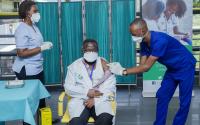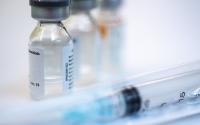[ad_1]
Table of Contents
NFL COVID-19 tracking yields lessons for fine-tuning control measures
An intensive COVID-19 prevention and surveillance system that the National Football League (NFL) put in place this season identified certain types of risky in-club transmission, which helped officials revise its high-risk contact definition and improve its protocols.
Representatives from the NFL and their colleagues, including Michael Osterholm, PhD, MPH, director of the Center for Infectious Disease Research and Policy, publisher of CIDRAP News, detailed their findings today in Morbidity and Mortality Weekly Report (MMWR).
As part of the NFL’s COVID-19 measures established last July, players and staff wore masks, physically distanced, were frequently tested, and wore proximity devices to assist with contact tracing. Through the end of November, 329 (2.9%) cases were found among about 11,400 players and staff.
Through early September, fewer than 10 cases were found per week, but during the last week of September and into October, there were 41 cases, 21 from inter-team transmission linked to a single club, which led to temporary closure of the facility. The increase mirrored the national increase in cases.
Contact tracing found several transmission instances that occurred during less than 15 minutes of exposure within 6 feet. Interviews found that short exposures included unmasked meetings in small rooms or while eating.
The NFL implemented several changes after the cluster of cases, which included shifting to a more intensive protocol—such as more frequent testing, avoiding higher-risk activities, and a focus on finding high-risk contacts—after someone tested positive. Some high-risk activities included ridesharing in personal vehicles and eating and drinking in close proximity.
Efforts helped decrease facility exposures, even though US COVID-19 transmission continued to rise over the same time span.
The authors wrote that COVID-19 prevention steps should be continually optimized based on available data, and even though the NFL’s protocols were resource-intensive, strategies such as more clearly characterizing close contacts and crafting more intensive protocols could apply to other settings, such as essential workplaces, nursing homes, and schools.
Jan 25 MMWR report
Pending results support full-dose anticoagulants for some COVID patients
Full-dose blood thinners are both safe and reduce vital organ support for moderately ill hospitalized COVID-19 patients, according to a National Institutes of Health (NIH) press release late last week.
While the three international trials investigating this matter have not been published yet, the NIH says that interim data for more than 1,000 moderately ill patients who received full doses of blood thinners (anticoagulants) showed superior results compared with lower dose levels.
The results also inspired further study to see if the treatment can lower COVID-19 mortality rates.
The NIH is drawing its conclusions from the Randomized, Embedded, Multi-factorial Adaptive Platform Trial for Community-acquired Pneumonia (REMAP-CAP) Therapeutic Anticoagulation; Accelerating COVID-19 Therapeutic Intervention and Vaccines-4 (ACTIV 4) Antithrombotics Inpatient; and Antithrombotic Therapy to Ameliorate Complications of COVID-19 (ATTACC) trials. “Moderately ill” was defined as hospitalized patients who did not need intensive care unit (ICU) admission or organ support such as mechanical ventilation at the time of recruitment.
“The trial investigators are now working as fast as possible to make the full results of the study available so clinicians can make informed decisions about treating their COVID-19 patients,” NIH said in the press release. “The trial results reported today complement the group’s findings announced in December that routine use of full-dose anti-coagulation when started in the ICU in critically ill COVID-19 patients was not beneficial and may have been harmful in some patients.”
Because of the promising results, all three trials have stopped enrollment. Mary Cushman, MD, ACTIV 4 trial investigator, told MedPage Today, “Based on the very stringent criteria used to stop the trial, I would change my practice. In other words, it is unlikely there would be a reversal of the finding.”
ATTACC principal investigator Ryan Zarychanski, MD, tweeted, “This will define a new standard of care for patients with COVID-19 in hospital but not on life support.”
Jan 22 NIH press release
Jan 22 MedPage Today article
Young kids unlikely to increase COVID rates during lockdown, study finds
Children 1 through 10 years old were unlikely to have increased COVID infection rates in southwest Germany in late spring 2020 during stay-at-home orders, according to a study published late last week by JAMA Pediatrics.
The researchers found that having a parent who was seropositive for COVID antibodies and a child who wasn’t was 4.3 times more likely than having a child who was seropositive and a parent who was seronegative (95% confidence interval [CI], 1.19 to 15.52). Besides indicating children’s low role in transmission, the researchers say the results can directly affect decisions to reopen childcare and schools.
The data quantified SARS-CoV-2 RNA and antibody prevalence in 2,482 child-parent pairs in Baden Württemberg, Germany, which had the second-highest case ratios in the country at 337 per 100,000 people. The researchers found 1.8% of parents had COVID antibodies, compared with 0.6% of children (95% CI, 1.2% to 2.4% and 0.3% to 1.0%, respectively). Virus-neutralizing activity was detected in 94.3% of the 70 immunoglobulin G–positive serum samples.
Only 2 participants (0.04%), a child-parent pair, tested positive for SARS-CoV-2 RNA.
During the study’s duration, from Apr 22 to May 15, 2020, the country had closed schools and non-emergency daycares, but the 23.4% of children who attended emergency daycares did not have significantly different COVID rates. Younger children appeared to have lower seropositivity rates, though: 0.8% in children 1 through 5 years versus 1.0% in children 6 through 10.
“This SARS-CoV-2 prevalence study, which appears to be the largest focusing on children, is instructive for how ad hoc mass testing provides the basis for rational political decision-making in a pandemic,” the researchers write.
Jan 22 JAMA Pediatr study
[ad_2]
Source link












